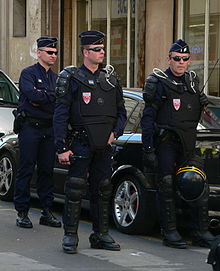Compagnies Républicaines de Sécurité
| Compagnies Républicaines de Sécurité | |
|---|---|
 CRS patch | |
| Common name | Compagnies Républicaines de Sécurité |
| Abbreviation | CRS |
| Agency overview | |
| Formed | 1944 |
| Employees | 13,000+ |
| Jurisdictional structure | |
| Operations jurisdiction | [[France]] |
| Operational structure | |
| Headquarters | Paris, France |
| Minister responsible | |


The Compagnies Républicaines de Sécurité (CRS) (Template:Lang-en) are the riot control forces and general reserve of the French National Police. The CRS were created on 8 December 1944 and the first units were organised by 31 January 1945. The CRS were reorganized in 1948. The task for which they are best known is crowd and riot control and re-establishment of order.
The expression les CRS refers to the whole force. It would be understood in the feminine plural insofar as the noun compagnie is feminine, but is typically used in the masculine to refer to the troops, most of whom are male (thus, masc.pl.). In French slang un CRS (masc.sg.) may mean "a CRS man".
History
After the Groupes mobiles de réserve (GMR) (created by the Vichy régime) were dissolved, the CRS were created on 8 December 1944. The CRS is a civilian corps (unlike the gendarmes, who are military), trained in anti-insurrection and antiriot techniques. The CRS had their first serious action in combatting the 1947 strikes in France.
Communist sympathisers were highly present among their ranks (which explains their history of engagement in the French Resistance, and according to some due to a desire to practice entryism).
The French Communist Party (PCF) took on the role of opposition to postwar governments. On 12 November 1947, there was a demonstration in Marseilles called by the CGT union and the PCF; the CRS (a majority of whom were Communists at the time), refused to act against it. After this, several component companies of the CRS were dissolved and reorganized in 1948 to remove Communist influence among their ranks.
Role
Each company is specialized in one field:
- Motorway police in urban areas
- Security of public buildings and crowd control. Some of these officers are cross trained and are used in summer as lifeguard team supervisors (they also enforce applicable laws in the beach).
- Mountain Rescue : one company and several sections administratively attached to a local company.
The CRS are grouped in units living in barracks. They generally operate away from their base town.
French mobile police forces
The two French anti-riot forces, the CRS and the Gendarmerie Mobile are often mistaken with each other, as their missions are similar, but they can be distinguished by uniform. The uniform of the CRS is blue (usually dark blue); the uniform of the gendarmes mobiles is black. The CRS wear a big red CRS patch; the gendarmes have stylized grenades. In January 2009, the French state implemented a rapprochement ("bringing together") of the police and the gendarmerie.[1] While this policy falls short of a complete fusion or merger, at least for now, this is likely to lead to more sharing of missions and less distinction between CRS and Gendarmes Mobiles in future.
Company composition
There are currently 61 companies; most of these companies have four platoons each, and others have six platoons. The four-platoon companies contain:
- 1 Commander
- 1 Captain
- 2 Lieutenants
- 1–4 Brigadiers-Major
- 12–25 Brigadiers-Chief
- 100–120 Guards
Organization
- 1 Central Directorate under a Director-general of the National Police in Paris;
- 7 Zonal Directorates in each of the military's defence zones;
- 60 General Service Companies (for the maintenance of public order);
- 1 VIP Escort compagny (CRS n° 1);
- 9 Autoroute Companies (Highway Patrol);
- 6 Zonal Motorcycle Units;
- 1 Mountain Group (Pyrenees);
- CRS Band (attached to CRS n° 1).[2]
Criticism
Their suppressive role and occasional abuse of force [3] towards protesters[4][5] or even school children [6] has led to criticisms among human rights supporters. There have also been a number of complaints against CRS officers on the subject of racism[7] and racial profiling.
References
- ^ http://www.vie-publique.fr/actualite/alaune/police-gendarmerie-rapprochement-officialise.html Police-gendarmerie : le rapprochement officialisé, January 6, 2009.
- ^ "Direction centrale des compagnies républicaines de sécurité". DCCRS - Le site officiel du ministère de l'Intérieur de l'Outre-mer et des Collectivités Territoriales, 07/08/2009. Accessed May 12, 2010.
- ^ "Six CRS poursuivis pour violences envers des jeunes". Le Post.
- ^ Manif pour les retraites : les CRS matraquent des journalistes, Rue89
- ^ J'ai été tabassée par la police à la fin de la manif pour les retraites Rue89
- ^ "Vidéos sur l'actualité et info en vidéo - Le Parisien vidéo". leparisien.fr.
- ^ http://www.timesonline.co.uk/tol/news/world/europe/article588472.ece
